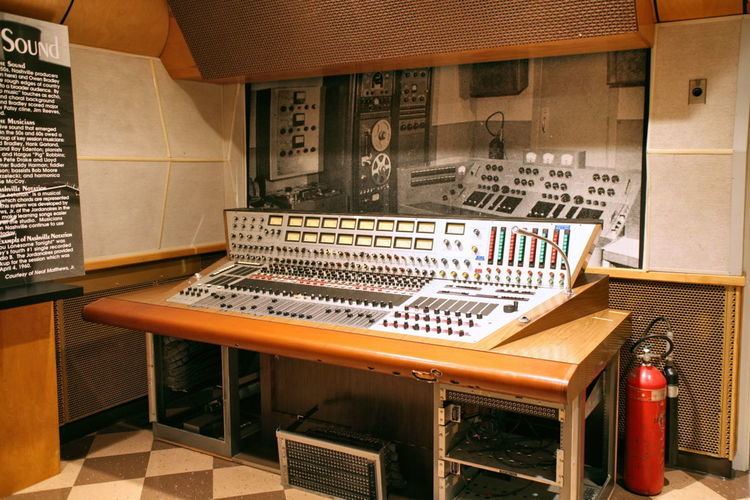Phone +1 615-416-2001 | ||
 | ||
Address 1611 Roy Acuff Pl, Nashville, TN 37246, USA Hours Open today · 10:30AM–2:30PMWednesday10:30AM–2:30PMThursday10:30AM–2:30PMFriday10:30AM–2:30PMSaturday10:30AM–2:30PMSunday10:30AM–2:30PMMonday10:30AM–2:30PMTuesday10:30AM–2:30PMSuggest an edit Similar Johnny Cash Museum, Parthenon, Belle Meade Plantation, Country Music Hall of Fame a, Gaylord Opryland Resort Profiles | ||
Rca studio b nashville elvis presley part 1
RCA Studio B is a recording studio in Nashville, Tennessee. Originally known simply as RCA Studios, it became famous in the 1960s for being a part of what many refer to as the Nashville Sound.
Contents
- Rca studio b nashville elvis presley part 1
- Rca studio b jim reeves
- Origins
- Learning facility
- List of artists recorded
- References
A sophisticated style characterized by background vocals and strings, the Nashville Sound both revived the popularity of country music and helped establish Nashville as an international recording center.
The National Park Service listed it on the National Register of Historic Places in 2012.
Rca studio b jim reeves
Origins
Built by Dan Maddox in 1956, it was constructed at the request of Chet Atkins and Steve Sholes to facilitate the needs of RCA Victor Records and other record labels. According to Chet Atkins, the plans for the studio were drawn up on a napkin by Bill Miltenburg, RCA's chief engineer and recording manager.
Construction took four months, and the studio was opened at the cost of $37,515. The recording studio is a single-story building with offices occupying the front but the area of the studio and control room has a second story that contains an echo chamber. The studio itself measures 42.5' by 27' by 13'. In 1960 and 1961 an addition was built to provide office space and rooms for tape mastering and a lacquer mastering lab. A larger studio was built on 17th avenue in 1964 that became known as Studio A; the existing studio was referred to as Studio B from that point on.
The first chief engineer was Bob Ferris, a man with a prickly personality who managed to make Atkins angry enough to have him moved elsewhere. Bill Porter replaced him at the end of March, 1959, and by June had mixed a number one hit: "The Three Bells" by The Browns. Porter considered the studio's acoustics problematic, with resonant room modes creating an uneven frequency response. To lessen the problem, he took some $60 from the studio's petty cash and bought fiberglass acoustic ceiling panels which he cut into triangles and hung from the ceiling at varying heights; these were dubbed "Porter Pyramids". Porter also marked "X"es on the floor where he discovered, by careful experimentation, the resonant modes to be minimal. Porter positioned lead vocalists, background vocalists and acoustic guitarists at microphones placed directly over his marks. After these improvements, Don Gibson recorded his album Girls, Guitars and Gibson in the studio. Porter later told an interviewer: "Everybody said, 'God, what a different sound!'"
In her 1994 memoir, My Life And Other Unfinished Business, Dolly Parton recounted how she was rushing to her first recording session at Studio B in September 1967 (shortly after having signed with RCA Victor) and, in her haste to make the session on time, drove her car through the side wall of the building. She noted that the spot where her car impacted the building is still visible.
Learning facility
In 1977 the studio was made available to the Country Music Hall of Fame for tours, and in 1992 it was donated to the Country Music Hall of Fame by the late Dan Maddox. Until 2001, it was operated as an attraction when the new home for the Hall of Fame was built in downtown Nashville.
Now the studio is co-operated by the Country Music Hall of Fame and Belmont University's Mike Curb College of Entertainment and Music Business program. Students use the facilities for classes learning the basic techniques of analog recording.
Nashville painter and singer/songwriter, Gil Veda, introduced to the Grand Ole Opry crowd as "The Spanish Hank Williams" in 1962, was the first Hispanic singer to record at RCA’s Studio B.
Daily tours of the studio are offered by the Country Music Hall of Fame and Museum.
List of artists recorded
Following is a list of some notable artists who recorded songs at Studio B.
